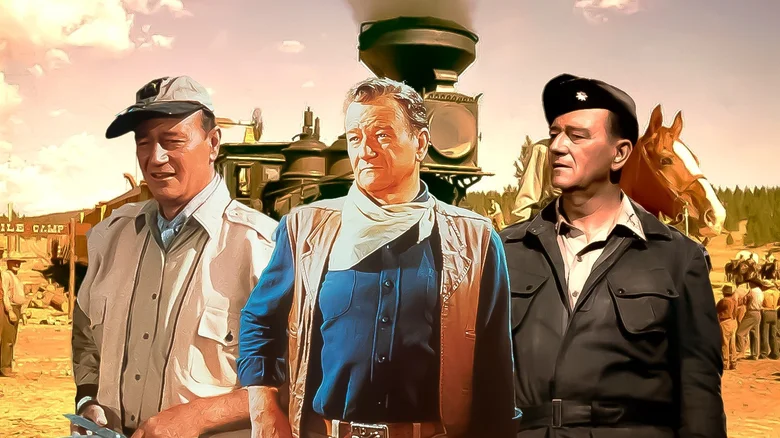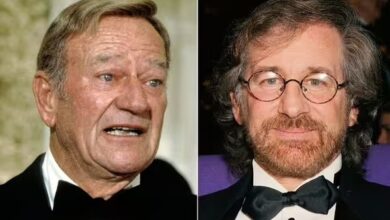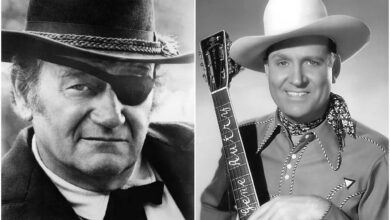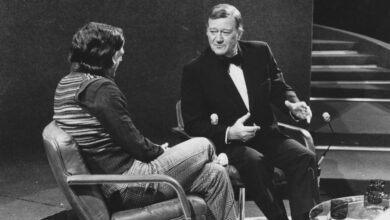The 27 Best John Wayne Films, Ranked

John Wayne once described himself as “just the paint for the palettes” of directors like John Ford and Howard Hawks, the filmmakers who steered him in films such as “Stagecoach” and “Red River.” Such modesty was characteristic of “The Duke,” whom Orson Welles described as one of the best-mannered actors in Hollywood. Yet Wayne was doing himself a disservice, for while he did benefit from the tutelage of two great filmmakers, he also worked long and hard to create the persona of “John Wayne,” a figure with a distinctive gait, an easy drawl, and tough morality.
To explore the career of John Wayne is to explore five decades of Hollywood history. Wayne acted opposite everyone from Barbara Stanwyck and Maureen O’Hara to Henry Fonda, James Stewart, and Kirk Douglas. The list of directors he worked with is just as impressive, too.
So, where does one start with John Wayne, both the complicated man and the cultural construct? Here are 27 films that trace the good — and some of the bad — of one of America’s most enduring icons.
27. The Horse Soldiers
United Archives/Getty Images
“The Horse Soldiers,” a Civil War drama, pitches John Wayne against one of my favorite actors of the era, William Holden. Such a pairing is interesting at face value, but their characters share a dynamic that makes the match up even more compelling. Wayne plays Colonel John Marlowe, a hard-nosed Union soldier with a clear sense of what’s right for his men. However, Holden’s Major Henry Kendall, a doctor conflicted by his medical and military oaths, has no such certainty. Naturally, these sensibilities cause conflict; first, the two men trade terse words, and later punches.
“The Horse Soldiers” is a middling entry in Wayne’s career, but the production is notable for several reasons. For the film, Wayne and Holden earned $775,000 each and 20% of the box office, which was an extremely lucrative deal by the standards of the late 1950s. Another anomaly is the death of stuntman Fred Kennedy, who was killed when he fell from a horse and broke his neck. John Ford knew Kennedy for years, and was so devastated by his death that he lost all interest in the production.
26. McQ
Warner Brothers
In the closing months of the 1960s, high on the success of “True Grit,” John Wayne turned down the lead role in “Dirty Harry,” a film and a character that would become a pillar of Clint Eastwood’s career. The Duke lived to regret his decision and, joining a wave of imitators, accepted the lead in “McQ,” a stodgy police procedural about drugs, corruption, and a mean anti-hero cop called Lon “McQ” McHugh.
Several measures are taken to spice up McQ’s anti-hero credentials. First is the Pontiac Firebird Trans Am, which Wayne never looks right in. That McQ would drive something American made is unquestionable, but I think he would have chosen something better suited to his age and padded stature. Something leisurely like a Lincoln, Cadillac, or Oldsmobile.
The other, more successful anti-hero measure is the Ingram MAC-10 submachine gun, which is Lon McQ’s answer to the .44 Magnum revolver. The Duke’s porky fingers are a better fit on the trigger than the Trans Am steering wheel, but the gunplay does not save “McQ” from being a bit of a damp squib.
25. Hondo
Warner Brothers/YouTube
Wayne gives another easygoing turn in “Hondo,” a short film about homesteading and conflict. The latter may seem the better fit for a John Wayne vehicle, but it is actually the homesteading that charges the appeal of John Farrow’s late career feature.
The 84-minute film establishes the main characters within the first ten minutes. Hondo (Wayne) and his dog Sam arrive at a homestead run by Angie (Geraldine Page) and her six year old son Johnny (Lee Aaker). You sense her fear but Hondo is another of Wayne’s chivalrous gentlemen. It’s a familiar and easy role, yet watching Angie fall for the Duke’s amiable ruggedness makes for a watchable old fashioned romance.
A few years ago, back when the “thug life” meme was popular on social media, you may have seen a clip of John Wayne throwing a boy into a river as a very literal “sink or swim” approach to parenting. Well, that scene was taken from “Hondo,” and it is a harsh but playful example of Wayne’s no-nonsense philosophy.
24. The Long Voyage Home
United Artists
“The Long Voyage Home” is about seafaring men during the early days of the Second World War. It may be a smaller title in the John Wayne and John Ford canon, but it is a very curious artifact for any student of film history.
One of the oddities is Wayne’s performance as Olsen, a Swedish seaman. It was the actor’s second leading role in a John Ford picture and it required the budding A-lister to drop his easy drawl and adopt a Swedish accent, which, as you can imagine, was executed with mixed results. I’m not sure what Swedes will make of it, but I think the Duke does an admirable job. His attempt relies on grammar rather than pronunciation — “I go home,” “We live on farm” — but Wayne captures Olsen’s youthful softness, which is an important part of the story’s pathos.
Another notable element is cinematographer Gregg Toland, who implemented his deep focus technique on this film, something he’d replicate to industry-changing effect the following year in the immortal “Citizen Kane.”
23. 3 Godfathers
Loew’s Inc.
Another collaboration between John Wayne and John Ford, “3 Godfathers” is a western reimagining of the story of the Three Wise Men that exchanges Bethlehem for the Arizona desert (although anyone who has visited Zabriskie Point will notice that it was actually filmed in Death Valley, California). Riding through this vast milieu are criminals Bob (Wayne), Pete (Pedro Armendáriz), and William, who’s better known as “The Abilene Kid” (Harry Carey Jr.). Arriving in Welcome, Arizona, the three men rob a bank and are chased out of town by Sheriff Buck Sweet (Ward Bond). Buck loses the outlaws, but not before shooting their water bag, leaving the trio dry in the desert.
Soon, Bob and his partners are caught in a struggle to survive. The scenery is classic Fordian beauty, but the film is honest about the danger of the oppressive landscape. Yet, even under this stress, the robbers prove their altruism when they find a pregnant woman dying in the back of a stranded stagecoach. After delivering the baby, the men become godfathers to the child and promise to get him to safety. “3 Godfathers” is another of Ford and Wayne’s minor collaborations, but it’s still an adequate western with a benevolent, biblical heart.
22. The Sands of Iwo Jima
Paramount/YouTube
John Wayne was keen to impress American troops during WW2. In 1943 and 1944, he toured Australia and the Pacific Islands, appearing before crowds of battle-hardened veterans, who jeered and booed the strapping young actor. Wayne may have been a star, but he had not reached the peak fame that would charm Vietnam troops two decades later. He was of fighting age, too, which can’t have endeared him to his audience, no matter his excuses for deferment. Wayne’s third wife, Pilar Pallette, wrote that accusations of draft dodging haunted the actor for the rest of his life, causing him to build a “super patriot” image to “atone for staying at home.”
“The Sands of Iwo Jima” is an early example of Wayne’s campaign to build an all-American screen persona. Wayne stars as John M. Stryker, a hard case sergeant tasked with whipping his men into shape before they storm the island of Iwo Jima. Wayne goes hard in the role, trying his best to embody the blood-and-guts toughness of George Patton and Douglas MacArthur. The troops of ’43 and ’44 may not have cared for Wayne, but the Academy nominated him for best actor in a leading role.
21. Brannigan
United Artists
“Brannigan” is another of Wayne’s “Dirty Harry”-inspired vehicles, but it learns from the mistakes of “McQ” by sticking to a simple formula: Wayne, a bad guy, and the streets of London. The location may be gimmicky, but these ingredients create what “McQ” should have been — two hours of brawny, eye-winking fun. You know you’re in for a good time during the gratuitously ’70s credits sequence, which ogles a .38 special revolver while the soundtrack goes hard on rolling drums, brass instruments, and funky guitar chords that are, for want of a better term, all very “boom chicka wah-wah.”
Now, “Brannigan” is not a shining example of the anti-hero cop genre, but it is a better time than it’s given credit for. Much of that is down to the Duke, who plays it easy with a mix of machismo and playfulness, especially during a farcical pub brawl that’s more Detective Frank Drebin than Inspector Harry Callahan. In addition, “Brannigan” doesn’t miss an opportunity to make fun of the British, particularly their perceived arrogance and fussy manners, both of which are personified by Sir Charles Swann, a Scotland Yard commander played by a posh but plucky Richard Attenborough.
20. The Comancheros
United Archives/Getty Images
“The Comancheros” is the penultimate film of director Michael Curtiz, one of the most prolific directors in cinematic history. His enormous filmography includes “Angels with Dirty Faces,” the proverbial 1930s gangster flick; “The Adventures of Robin Hood,” the swashbuckling Errol Flynn actioner; and “Casablanca,” one of Hollywood’s most celebrated films. “The Comancheros” hasn’t endured like those three classics, but it is a robust farewell to the workmanlike director.
John Wayne stars in the film as Captain Jake Cutter, a Texas Ranger in 1843 who captures Paul Regret (Stuart Whitman), a fugitive wanted for the killing of a judge’s son. Cutter transports Regret back to Louisiana until they run into the Comancheros, an outlaw gang who trade in weapons, liquor, and murder. It’s effectively a buddy film in which men on opposite sides of the law must work together in the face of a greater adversary. In other words, it’s “Midnight Run” with cowboy boots and spurs.
19. Big Jake
United Archives/Getty Images
“Big Jake” premiered on May 26, 1971, John Wayne’s 64th birthday. It was already his third western of the decade, and Wayne was so comfortable in felt cowboy hats that he must have known the genre by rote.
By this point, a mass of filmgoers had accused Wayne of playing the same character over and over again. The actor was fully aware of this, and mentioned it during an interview with Roger Ebert in 1969, reasoning that he played different characters in films such as “The Quiet Man” and “Yellow Ribbon.” He also challenged his critics with an interesting comment on the qualities of movie stardom. “Thousands of good actors can carry a scene,” Wayne said, “but a star has to carry the scene and still, without intruding, allow some of his character into it.”
This point is relevant to “Big Jake.” Everything about it is old hat, but through some combination of cadence, swagger, and legacy, John Wayne lifts a project that could have been thoroughly cut and paste. What is “Big Jake” about? Well, there’s a hostage, a ransom, and a gunslinging posse hired to collect it. There’s also a level of violence that is above that usually found in a John Wayne western, although still below that of Sergio Leone and Sam Peckinpah. Perhaps the most unique element of “Big Jake” is the appearance of Wayne’s son, Patrick, who gives an angsty performance as Big Jake’s first born.
18. The Sons of Katie Elder
Paramount Pictures
“The Sons of Katie Elder” is another western saga about land, feuds, and gunfights. The titular sons are John (Wayne), a notorious gunslinger; Tom (Dean Martin), a career gambler; Matt (Earl Holliman), a former shopkeeper; and Bud (Michael Anderson Jr.), an unruly student who wants to be like his siblings.
The brothers convene after the death of their mother, Katie Elder, an honorable matriarch beloved by all but the Hastings family, a cynical clan of gunsmiths who lay claim to the Elder ranch. They say that Bill, the Elder patriarch, lost the land during a game of blackjack, after which he was shot dead by an unknown killer. Smelling a rat, the Elder brothers investigate their father’s death, leading them to an explosive confrontation with the Hastings men. It’s a competent if unremarkable film with fair action scenes and a noticeably anxious turn from a young Dennis Hopper, who would become a counter-culture icon just four years later in “Easy Rider.”
17. They Were Expendable
MGM/YouTube
Released in December 1945, just three months after Japan’s formal surrender, “They Were Expendable” takes audiences back to the Battle of the Philippines, which raged from December 8, 1941 to May 9, 1942 (via Britannica). This was a time long before Iwo Jima, Okinawa, and the numerous other American victories in the Pacific war. It was a time when America, shaken by the attack on Pearl Harbor, surrendered to the advance of a swift, organized, and merciless enemy.
Dire though this context may be, the Japanese are not the only enemies in this surprisingly cynical war film. Lt. “Rusty” Ryan (John Wayne) must also contend with his complacent superiors, who dismiss his squadron’s PT boats as weak and ineffective. Respect is granted only once their base falls under heavy attack, which is obviously too late.
Much of the film’s driving force comes not from Wayne but from Robert Montgomery, who received top billing on the picture. Like Wayne’s other roles prior to “Red River,” he is an easygoing presence, particularly when contrasted with Montgomery’s fiery turn.
16. Rio Bravo
Warner Bros.
“Rio Bravo” is a film with many admirers. The western is one of John Carpenter’s five favorite films and Quentin Tarantino described it as “one of the greatest ‘hang out’ movies of all time.” I’m happy for Carpenter and Tarantino, I really am. I hope that any new viewer will share their enthusiasm, too. But for me, the “towering” qualities of “Rio Bravo” are elusive.
Personally, I did not want to hang out with Sheriff Chance (John Wayne), Dude (Dean Martin), Colorado (Ricky Nelson), Feathers (Angie Dickinson), Carlos (Pedro Gonzales) and Stumpy (Walter Brennan). Indeed, I found their exchanges all rather strained. Dude is washed up and strung out, Carlos fizzes with neurotic panic, and Feathers flits between seduction and histrionics. I wasn’t gripped by their purpose, either, which is to hole up, organize, and confront Nathan Burdette, a violent rancher.
In case you were wondering, the similarities to “High Noon” here are intentional. Wayne and Hawks sought to counteract that film — in which Gary Cooper must defend cowardly townsfolk alone — by telling a story of kinship and crackpot defiance. The problem is the leisurely “hang out” pace. Both films hinge on an encroaching climactic shootout, but “High Noon” does so in real time, winding tension with much skill. “Rio Bravo,” meanwhile, dilutes the prospect of conflict with about an hour of fraternizing. Still, personal reservations aside, “Rio Bravo” is an interesting landmark of the genre that must figure in any conversation about John Wayne.
Read More: https://www.slashfilm.com/1184671/the-best-john-wayne-films-ranked/





